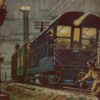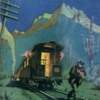Does anyone frame drawings/artwork they find in train magazines?
The reason I ask is I have all the issues of Mainline Modeler and there are some fantastic drawings in many of them. I'd like to frame a few, but wonder what to do about the creases and staple holes. Many are in O scale.
The "collection" is taking up space and to be honest, I hardly ever look at them anymore unless I have a project and need to find some data. Just going thru each magazine to select what drawings I would like to frame is a daunting task, but hey, I'm retired so have plenty of time (I hope).











